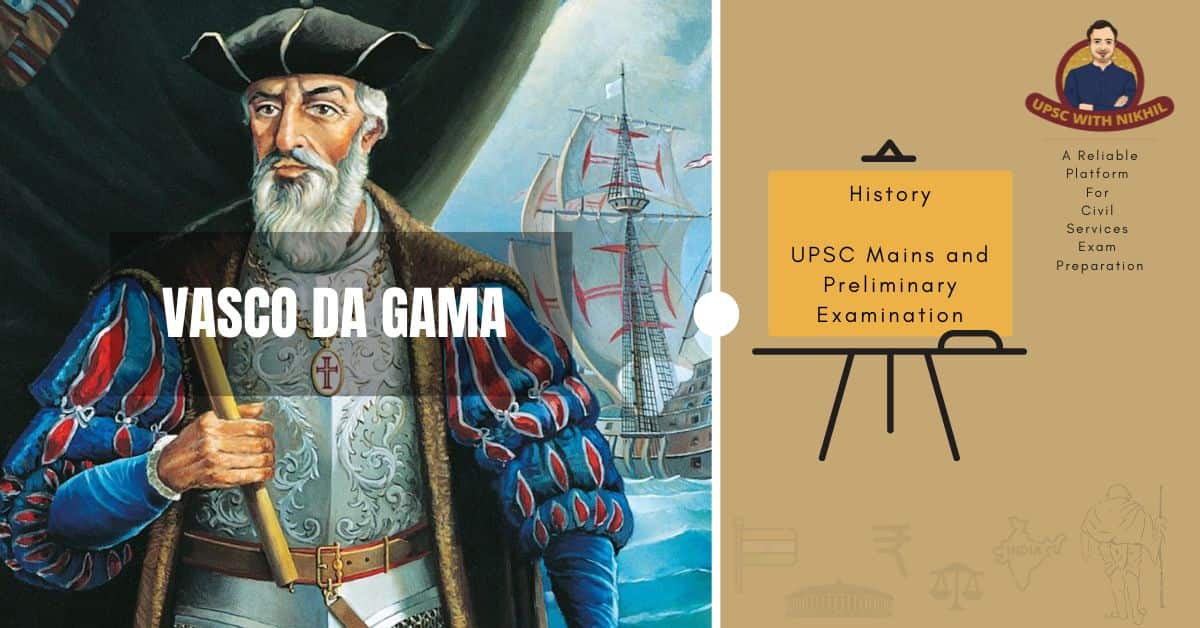Vasco Da Gama Upsc
Introduction
Vasco da Gama, a Portuguese explorer, made history as the first European to go by sea to India. The arrival in Calicut in May 1498 of three ships commanded by Vasco Da Gama and piloted by a Gujarati named Abdul Majid had a profound effect on Indian history. Vasco da Gama's landing at Calicut in 1498 is sometimes cited as the beginning of a new period in world history, particularly in relations between Asia and Europe.
Vasco Da Gama
• Vasco da Gama was likely born in a house close to the Nossa Senhora das Salas church in Sines, one of the few seaports on the Alentejo coast in southwest Portugal, in 1460.
• Since the early 15th century, Prince Henry the Navigator-led Portuguese expeditions have been making their way along the African coast in search of west African riches, particularly gold and slaves.
• On July 8, 1497, Vasco da Gama departed Lisbon in command of a fleet of four ships with a crew of 170 men.
• The journey from Africa to India and back was longer than the equator's circumference.
• Two years after setting sail from Lisbon, Portugal, Vasco da Gama arrived in Kozhikode (Calicut), Kerala, on the western seacoast of India on May 20, 1498.
• A European had never before arrived in India by watercraft.
• Vasco da Gama is credited with finding the sea passage to India as a result.
Vasco Da Gama's Arrival And Its Importance
• The arrival in Calicut in May 1498 of three ships commanded by Vasco Da Gama and piloted by a Gujarati named Abdul Majid had a profound effect on Indian history.
• The Hindu Zamorin (Samoothiri), the ruler of Calicut, was unconcerned about the Europeans' motives.
• His kingdom's prosperity was a result of Calicut's position as an entrepot, therefore he welcomed Gama with open arms.
• The prosperous Arab traders on the Malabar Coast were cautious of the Portuguese setting up shop there.
• The Indian Ocean commercial system included numerous players for ages, including Indians, Arabs, and people from the east coast of Africa, Chinese, and Javanese.
• Although everyone was in it for the money, these participants had adhered to some unwritten standards of conduct, and none had sought out absolute domination.
• The Portuguese changed that by aiming to eliminate rivals, mainly Arabs, in order to monopolize the lucrative eastern trade.
• Vasco da Gama visited India for three months. He brought a pricey cargo with him when he left, and he successfully sold the goods on the European market.
• The fact that Europeans would have had to pay 10 times as much for the same amount of pepper if they had been forced to purchase through Muslim middlemen serves as an example of the importance of direct access to the pepper trade.
• Other money-hungry traders from Europe were persuaded to go to India and conduct business there.
• Vasco de Gama visited India once more in 1501.
• The Zamorin refused to shun Arab traders in favor of the Portuguese when Vasco Da Gama combined commercial greed with murderous animosity and exacted retribution on Arab trade everywhere he could.
• He had ended his relationship with the Zamorin.
• Vasco da Gama constructed a trading facility at Cannanore.
• Cochin, Cannanore, and Calicut progressively developed into important Portuguese commercial hubs.
• Under the pretence of protecting the manufacturers and their business endeavors, the Portuguese gradually obtained permission to garrison these centres.
• Da Gama stocked up on spices in Cochin and Cannanore, two nearby kingdoms at conflict with the Zamorin, whose allegiances had been formed by earlier Portuguese expeditions. The 4th armada departed from India in early 1503.
• The Zamorin and da Gama had a rocky relationship from the beginning since vasco da Gama didn't pay regular customs taxes.
• In September 1503, having essentially failed in his endeavor to defeat the Zamorin, Vasco da Gama returned to Portugal.
• In order to keep an eye on the Indian coast and protect the Portuguese businesses in Cochin and Cannanore from the Zamorin's anticipated reprisal, Vasco da Gama deployed a small squadron of caravels under the command of his uncle Vicente Sodre.
• Vasco Da Gama was conspicuously overlooked in 1505, when Francisco de Almeida was chosen as the first ruler and viceroy of Portuguese India by Portuguese King Manuel I of Portugal.
• After being initially buried at St. Francis Church in Fort Kochi, Kochi, Vasco da Gama's remains were subsequently returned to Portugal in 1539.
• The remains of Vasco da Gama were reinterred at Vidigueira in a coffin covered in gold and jewels.
• In Belem, Lisbon, within the Jeronimos Monastery, is where you may find Vasco da Gama's grave.
• Early in the 1500s, close to the location of Vasco da Gama's first journey, the Hieronymite Monastery at Belem was constructed. It was funded by a tax on the proceeds of the yearly Portuguese India Armadas and would later become the necropolis of the Portuguese royal dynasty of Aviz.
• Vasco da Gama Church is a private residence on the island of Saint Helena and a church in Kochi, Kerala.
• Another place bearing his name is Vasco, a suburb of Cape Town.
Conclusion
The arrival of Vasco da Gama in Calicut in 1498 is sometimes cited as the beginning of a new era in world history, particularly in the connection between Asia and Europe. Although economic relations between Asia and Europe date back to antiquity, the creation of direct sea communication between the two meant more than just the fulfilment of a long-held ambition.


